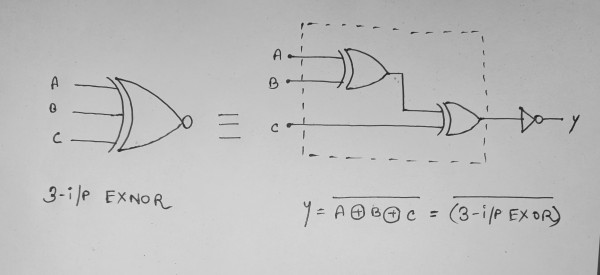Yes, EX-NOR Gate follows Associativity.
Associativity Definition: Three elements A, B, C in a non-empty set G are Associative if
$(A \cdot B)\cdot C= A\cdot (B\cdot C)$
(Where $\cdot$ is any binary operator)
Here is some $Standard \ Source$ for more details about $Associative \ Property$ –
- Wikipedia
- Introduction to Group Theory, MIT
- Introduction to the Theory of Finite Groups, Stanford University
XNOR Gate: If both of the given inputs are equal, it gives output 1. It is also called as Equality Detector,

(Source: M. Morris Mano)
Now, let us draw the truth table:
|
A
|
B
|
C
|
(A ⊙ B) ⊙ C
|
A ⊙ (B ⊙ C)
|
A ⊙ B ⊙ C
|
A ⊕ B ⊕ C
|
|
0
|
0
|
0
|
0
|
0
|
0
|
0
|
|
0
|
0
|
1
|
1
|
1
|
1
|
1
|
|
0
|
1
|
0
|
1
|
1
|
1
|
1
|
|
0
|
1
|
1
|
0
|
0
|
0
|
0
|
|
1
|
0
|
0
|
1
|
1
|
1
|
1
|
|
1
|
0
|
1
|
0
|
0
|
0
|
0
|
|
1
|
1
|
0
|
0
|
0
|
0
|
0
|
|
1
|
1
|
1
|
1
|
1
|
1
|
1
|
So from the above truth table we can observe that,
(A ⊙ B) ⊙ C ≡ A ⊙ (B ⊙ C) ≡ A ⊙ B ⊙ C ≡ A ⊕ B ⊕ C ≡ Σm (1,2,4,7)
Hence, (A ⊙ B) ⊙ C = A ⊙ (B ⊙ C), i.e EX-NOR follows Associativity.
Some additional points to remember :
$EX-OR \Rightarrow {Detects}\ {odd}\ {no}\ {of}\ {1's}$
$EX-NOR \Rightarrow {Detects}\ {even}\ {no}\ {of}\ {0's}$
$EX-NOR = {EX-OR}$
Because, for odd no of inputs, Odd no of 1’s means Even no of 0’s and vice versa. (By intuition)
Let say, Inputs 001 → Here No of 0’s = 2 (even) and No of 1’s = 1(odd)
$EX-NOR = \overline{EX-OR}$
Truth Table:
|
A
|
B
|
A ⊙ B
|
A ⊕ B
|
|
0
|
0
|
1
|
0
|
|
0
|
1
|
0
|
1
|
|
1
|
0
|
0
|
1
|
|
1
|
1
|
1
|
0
|
3-input EXOR Function is $SAME$ as 3-input EXNOR Function.
But, 3-input EXOR Gate is $NOT$ same 3-input EXNOR Gate.
-
The Implementation of 3 i/p EX-NOR Gate:

This is the way to implement 3-i/p XNOR $Gate$, which is equivalent to $complement$ of 3-i/p XOR gate i.e 3 i/p XOR + NOT.
A ⊙ B ⊙ C = A ⊕ B ⊕ C [For Function]
A ⊙ B ⊙ C = $\overline{A \oplus B \oplus C}$ [For Gate]
Good Read: GO TS - 1 question on 3 input XNOR
Video Explanation: XNOR Gate Vs XNOR Function | 3 Inputs XNOR gate